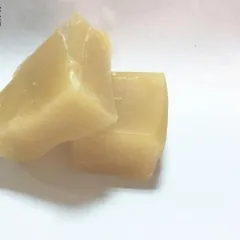- Home
- Products
- Elementary
- Boride Powder
- 3D Printing Powder
- Sulfide Powder
- Oxide Powder
- Carbide powder
- Nitride Powder
- Silicide Powder
- Hydride Powder
- Telluride Powder
- Selenide Powder
- Stearic Acid Series
- Phosphide Powder
- Nanoparticles
- Metal Alloy
- MAX Phase
- Lithium Battery Anode
- Surfactant
- Molecular sieves
- Concrete Admixtures
- Cladding of metals
- News
- Blog
- Contact
- About
Polyglyceryl-3 palmitate CAS 79777-28-9
Colorless to yellowish, solid Polyglyceryl-3 Palmitate.
Description of Polyglyceryl-3 palmitate :
Physical state: Polyglycerol-3 palmitate is a white or yellowish solid with hygroscopic properties.
Solubility: It can dissolve in various organic solvents, such as ethanol, acetone, etc., but is also soluble in water. This makes it widely used in the cosmetic, food and pharmaceutical industries.
Stability: Polyglycerol-3 palmitate has good chemical stability and tolerance to acids, bases, salts, and oxidants.
Gentleness: Because it is derived from natural plants, it has good gentleness and no irritation or allergic reaction to the skin and eyes.
Emulsification: Polyglycerol-3 palmitate has excellent emulsifying properties and can effectively convert oily substances into stable emulsions. This property allows it to be used as an emulsifier in the cosmetics and food industries.
Thickening: It can also increase the viscosity of the solution so that it plays the role of a thickener in cosmetics, improving the feel and stability of the product.
Moisturizing properties: Polyglycerin-3 palmitate can effectively moisturize the skin, keeping the skin moist and smooth.
Biodegradable: Polyglycerol-3-palmitate is biodegradable, which means it can be broken down into harmless substances by microorganisms in the natural environment, reducing environmental pollution.

Technical Parameters of Polyglyceryl-3-palmitate
| Product Code | Shortname | Density | Appearance |
|---|---|---|---|
| Polyglyceryl-3 palmitate | N/A | N/A | Colorless to yellowish Solid |
Applications of Polyglyceryl-3 palmitate
:
Cosmetics field:
Lotions and creams: As an emulsifier, polyglycerol-3-palmitate improves the stability of lotions and creams, prevents oil and water separation, and helps to create a delicate, smooth texture.
Moisturizing products: Its moisturizing and moisturizing properties make polyglycerol-3-palmitate an ideal ingredient for moisturizing products that help improve skin moisture retention and feel.
Makeup: Polyglycerin-3 palmitate helps improve the spreadability, uniformity, and durability of lipstick, foundation, and other makeup.
Shampoos and body washes: as a thickener and stabilizer, it helps to form a rich, stable foam and improves the stability of the product.
Food Industry:
Dairy products: As an emulsifier and stabilizer, polyglycerol-3 palmitate can improve the taste and stability of dairy products, such as yoghurt, cheese, etc.
Beverages: In beverages, it can be used as a thickening agent and stabilizer to improve the taste and texture of the product.
Fatty foods: When cooking and processing fatty foods, polyglycerol-3 palmitate can improve food stability and extend the shelf life.
Pharmaceutical Industry:
Drug preparation: As excipients or additives, polyglycerol-3-palmitate can prepare drugs to improve their solubility stability or reduce side effects.
Drug delivery: In the drug delivery system, it helps form stable drug nanoparticles or microspheres, improving drug targeting and delivery performance.
Personal Care Products:
Hand sanitizers and body washes: As a thickener and stabilizer, polyglycerol-3-palmitate can improve the texture and stability of products.
Oral care products: In toothpaste, it can be used as a moisturizer and thickener to improve the taste and stability of the product.
Production Method of Polyglyceryl-3 palmitate :
Raw material preparation: The main raw materials required for producing poly glycerine-3 palmitate include poly glycerine, palmitic acid, catalysts and other necessary auxiliaries. Before starting production, it is necessary to ensure that the quality and purity of all raw materials meet the standard and prepare the appropriate amount of water and solvents.
Esterification: Esterification is a key step in the production of polyglycerol-3-palmitate. In this step, polyglycerol and palmitic acid are esterified by a catalyst to produce polyglycerol-3-palmitate. It is necessary to control the temperature, pressure and stirring speed during the reaction process to ensure the complete esterification reaction and the formation of the target product.
Neutralization and washing: After completing the esterification reaction, it is necessary to convert the excess acid into salts by adding an appropriate amount of alkali (such as sodium hydroxide, calcium hydroxide, etc.) to precipitate the poly glycerine-3 palmitate. It is then washed to remove salts and residual impurities from the reaction solution. This step aims to improve the purity and quality of the product.
Dehydration: A certain amount of water is generated during the reaction, so it needs to be dehydrated. Common dehydration methods include heating, evaporation, and vacuum drying. After dehydration, solid polyglycerol-3-palmitate can be obtained.
Crushing and sieving: The dehydrated polyglycerol-3 palmitate needs to be crushed and sieved to obtain the desired size of the product. According to the application's requirements, different particle sizes of polyglycerol-3-palmitate can be selected.
Packing & Shipping Polyglyceryl-3:
Polyglyceryl-3-palmitate is available in a variety of different packaging options.
Polyglyceryl-3 palmitate packing:
1kg per bottle, 25kg per barrel, or 200kg per barrel.
Shipping Polyglyceryl-3 palmitate
The shipment can be made by sea, air or express as soon after payment as possible.
Polyglyceryl-3 palmitate Properties
| Alternative Names | Polyglycerol -3 monopalmitate |
| CAS Number | 79777-28-9 |
| Compound Formula | N/A |
| Molecular Mass | N/A |
| Appearance | Solid colorless to yellowish |
| Melting Point | N/A |
| Boiling Point | N/A |
| Density | N/A |
| Solubility In H2O | N/A |
| Exact Ma | N/A |
Polyglyceryl-3 palmitate Health & Safety Information | |
| Sign Word | N/A |
| Hazard Statements | N/A |
| Hazard Codes | N/A |
| Risk Codes | N/A |
| Safety Declarations | N/A |
| Transport Information | N/A |
Inquiry us
PREVIOUS Surfactant
LAS Sodium Linear-Dodecylbenzenesulfonate CAS 25155-30-0
NEXT Surfactant